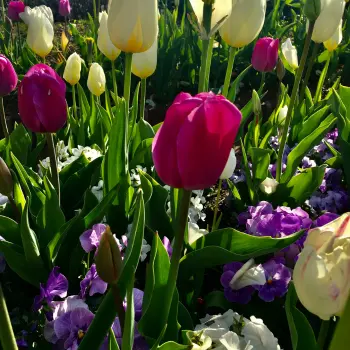Unexpected Spring Frosts

As the days grow longer and the first flowers begin to bloom, it’s easy to think that winter is behind us. However, spring frosts can still catch gardeners off guard, potentially damaging tender plants and setting back all your hard work. Whether you’re growing delicate flowers, young vegetables, or newly planted shrubs, protecting them from sudden cold snaps is essential. Here’s how you can shield your plants and ensure they thrive through unpredictable spring weather.
Why are there Spring Frosts?
Spring frosts occur when temperatures drop below freezing (0°C) overnight, forming ice crystals on plant surfaces. These freezing temperatures can harm plant cells, causing wilting, blackened leaves, or even plant death. Some plants are more susceptible than others—tender seedlings, tropical plants, and early blooms are especially vulnerable. Here's how you can see a spring frost coming:
Keeping an eye on the weather forecast is crucial for protecting your garden. Look out for these warning signs:
- Clear Skies: Without cloud cover, heat escapes more easily, leading to colder nights.
- Calm Winds: Still air allows frost to settle on plants, increasing the risk of damage.
- Sudden Temperature Drops: If temperatures are predicted to drop near freezing, prepare to take action.

How to protect your plants from frost
When frost threatens, take these precautions to keep your plants safe:
1. Cover Your Plants
Using covers traps warmth and protects plants from freezing air. Options include:
- Frost Cloths & Horticultural Fleece: Specially designed for plant protection, these breathable fabrics allow moisture and light in while shielding against frost.
- Bed Sheets & Blankets: A quick and effective solution for covering larger areas. Make sure they don’t touch delicate leaves to prevent ice formation.
- Plastic Sheets: While useful, plastic should never directly touch plants, as it can cause more damage. Use stakes or hoops to create a tent-like structure.
2. Use Cloches for Individual Plants
Cloches act as mini-greenhouses, trapping heat and moisture around individual plants. Try these options:
- Glass or Plastic Cloches: Ideal for protecting tender flowers and small vegetable plants.
- DIY Cloches: Cut the bottoms off plastic bottles or milk jugs and place them over plants for quick protection.
- Upside-Down Pots or Buckets: A simple method for shielding small plants overnight.
3. Move Potted Plants Indoors
If you have plants in containers, bring them into a garage, shed, or enclosed porch when frost is expected. Even moving them against a house wall can provide some protection, as buildings radiate warmth.
4. Water Before a Frost
Damp soil retains heat better than dry soil. Water your plants in the late afternoon before a predicted frost to help keep roots warm. Avoid overwatering, as soggy roots can lead to other problems.
5. Mulch for Insulation
Applying mulch around the base of plants helps trap warmth in the soil. Use materials like straw, bark, or dry leaves to create a protective barrier. This method is especially useful for perennials and young seedlings.
What to do after a spring frost?
If your plants are affected by frost, don’t panic. Follow these steps to help them recover:
- Wait Before Pruning: Frost-damaged leaves may look unsightly, but wait until warmer weather to trim them—this prevents additional stress.
- Water Gently: If plants appear wilted, water them lightly in the morning to help them recover.
- Provide Sunlight: Move potted plants back to sunny areas and monitor their condition over the next few days.
Be on the lookout for spring frosts
Spring frosts may be unpredictable, but with the right precautions, you can protect your plants and keep your garden thriving. Whether you cover plants with blankets, use cloches, or bring pots indoors, these simple steps will help ensure your plants stay safe from sudden cold snaps. Stay prepared, keep an eye on the forecast, and enjoy a successful growing season!




